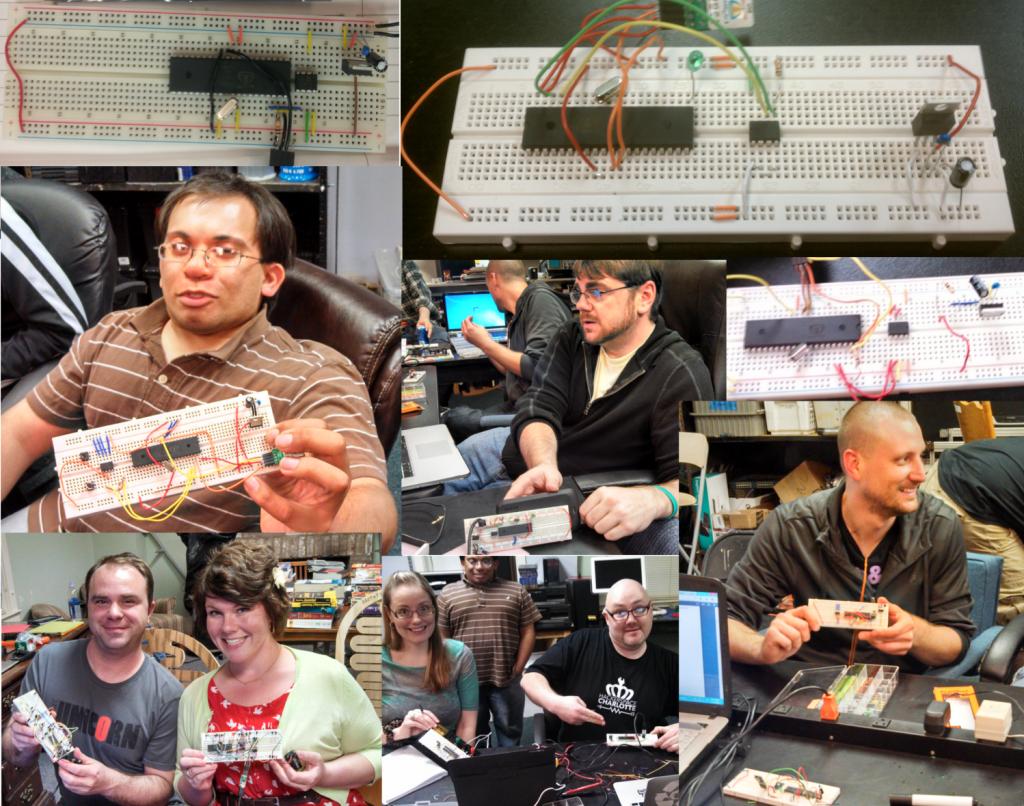Pragmatic Electronics, PCB Design, Propeller based class in Charlotte NC.
 __red__
Posts: 470
__red__
Posts: 470
On the first night we had 7 people, we defined Potential, Current, Resistance and taught them Ohm's Law, how to read a datasheet and how to use the example circuit in the LM2937 datasheet to build a power supply on their Breadboard for their project. Then I exploded an electrolytic capacitor because we all have to see that at least once in our lives :-)
On the second night we had over 20 people (but only 17 kits - unbelievable(!)), we taught them P = IV, how to measure P, I and V in a circuit with resistances in series and parallel. After their brane had melted (at a power they calculated to be 27.35W), they took the example "Minimum circuit" from the propeller datasheet and built their own Propeller Board with a single LED then loaded Blink.spin. The "Hello World" if you will of the course. I gave them no guidance, no "Wire from B7 to K5". Just the instructions "Make the connections on the datasheet". I also blew up a second capacitor for good measure :-D
At the end of the night we had sixteen (16) people who enrolled and walked away from the class with a microcontroller circuit that they assembled from first principles.

That's a brief montage of the few people who emailed me photos from the evening! :-)
Next week, connecting up hardware and collecting ideas as to what people want to build for their projects.
The week after I teach them how to draw the schematic in diptrace and get them started on PCB design.
After that, the PCB designs will be finished and we'll do hackerspace PCB fabrication and shipping of gerbers to China.
While that's away we'll be teaching propeller programming so they'll be able to make a start on writing the firmware for their devices.
In the final weeks, it will be assembly and review.
Then we repeat.
Thanks again to Ken and the Parallax crew for their support and encouragement for this project. This class is looking to be the most successful classes we've held!
Thanks
Red.
On the second night we had over 20 people (but only 17 kits - unbelievable(!)), we taught them P = IV, how to measure P, I and V in a circuit with resistances in series and parallel. After their brane had melted (at a power they calculated to be 27.35W), they took the example "Minimum circuit" from the propeller datasheet and built their own Propeller Board with a single LED then loaded Blink.spin. The "Hello World" if you will of the course. I gave them no guidance, no "Wire from B7 to K5". Just the instructions "Make the connections on the datasheet". I also blew up a second capacitor for good measure :-D
At the end of the night we had sixteen (16) people who enrolled and walked away from the class with a microcontroller circuit that they assembled from first principles.

That's a brief montage of the few people who emailed me photos from the evening! :-)
Next week, connecting up hardware and collecting ideas as to what people want to build for their projects.
The week after I teach them how to draw the schematic in diptrace and get them started on PCB design.
After that, the PCB designs will be finished and we'll do hackerspace PCB fabrication and shipping of gerbers to China.
While that's away we'll be teaching propeller programming so they'll be able to make a start on writing the firmware for their devices.
In the final weeks, it will be assembly and review.
Then we repeat.
Thanks again to Ken and the Parallax crew for their support and encouragement for this project. This class is looking to be the most successful classes we've held!
Thanks
Red.


Comments
Page 5 of 36 of the Propeller Datasheet. Same circuit I used to design my M44D40+ module.
Your build-and-take approach is a really good one. Puts people close to the hardware and give them a personal reward at the end.
Nice chatting with you. Looking forward to meeting you sometime at the Hackerspace Charlotte.
Doc